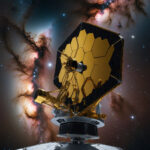The enigma of dark matter has puzzled scientists for decades, with its presence inferred through gravitational effects rather than direct observation. A recent study has brought forth fascinating evidence of antimatter discovered in cosmic rays, suggesting a potential breakthrough in the search for dark matter candidates, particularly Weakly Interacting Massive Particles (WIMPs). This development not only intrigues astrophysicists but also offers new avenues for understanding the fundamental structure of our universe.
For years, WIMPs were hailed as prime candidates for dark matter, touted for their low interaction rates with normal matter—interacting primarily through gravity and the weak nuclear force. This unique characteristic renders them incredibly difficult to observe directly. Numerous studies have aimed to identify specific types of WIMPs, analyzing their expected emissions based on theoretical models. However, as research progressed, many WIMP candidates were dismissed, casting doubt on the once-promising hypothesis.
Recently, observations from the Alpha Magnetic Spectrometer (AMS-02), which operates aboard the International Space Station, have reignited interest in these elusive particles. While scanning cosmic rays, AMS-02 detected traces of ‘antinuclei,’ specifically antihelium, a finding which could be instrumental in shedding light on the nature of dark matter.
To comprehend the implications of antimatter in this context, one must first understand its basic principles. Antimatter consists of particles that carry opposite charges compared to their matter counterparts. Take positrons, for instance—these are essentially the antimatter version of electrons, possessing a positive charge. The collision of matter and antimatter results in a powerful annihilation process, unleashing energy in the form of gamma radiation. Although instances of antimatter are rare in the universe, its formation is theorized to have begun with the Big Bang and continues sporadically during certain cosmic phenomena.
The detection of antihelium by AMS-02 is particularly noteworthy. According to the theory, when WIMPs annihilate, they produce both matter and antimatter. Thus, the presence of antihelium nuclei—especially the exceptionally rare antihelium-3 and antihelium-4—suggests that such particles may emerge from higher energy processes, possibly linked to WIMP interactions. Current models predict that antihelium should only form in exceptionally small quantities through typical cosmic-ray interactions, with estimations projecting roughly one event every few decades. To the astonishment of scientists, AMS-02 recorded about ten occurrences, dramatically exceeding those predictions.
What does this mean in the broader search for dark matter? The implication is that if these antihelium particles come from WIMP interactions, it opens a crucial window into understanding dark matter’s exotic nature. Antihelium-3 could fit into some of the optimistic WIMP theories, but the detection of the heavier antihelium-4 challenges these concepts significantly. The formation of antihelium-4 would be unexpected even under the best-case scenarios for WIMP interactions, thereby encouraging researchers to explore beyond traditional WIMP models.
This recent discovery has important ramifications for how we approach the dark matter mystery. It indicates that we may be moving towards an understanding of more exotic particles that could account for the effects attributed to dark matter. If these observations point to new particle physics, scientists may need to revise existing theories and develop new frameworks to explain the considerable discrepancies between the expected and observed antimatter levels in cosmic rays.
In conclusion, the detection of antihelium ranges suggests that a profound understanding of dark matter may be within reach. As researchers continue to analyze these findings, antimatters could offer pivotal insights into the nature of dark matter, possibly unlocking answers to some of the universe’s deepest questions. Further investigations will surely reveal whether WIMPs or other unknown particles are at play in this grand cosmic drama.












